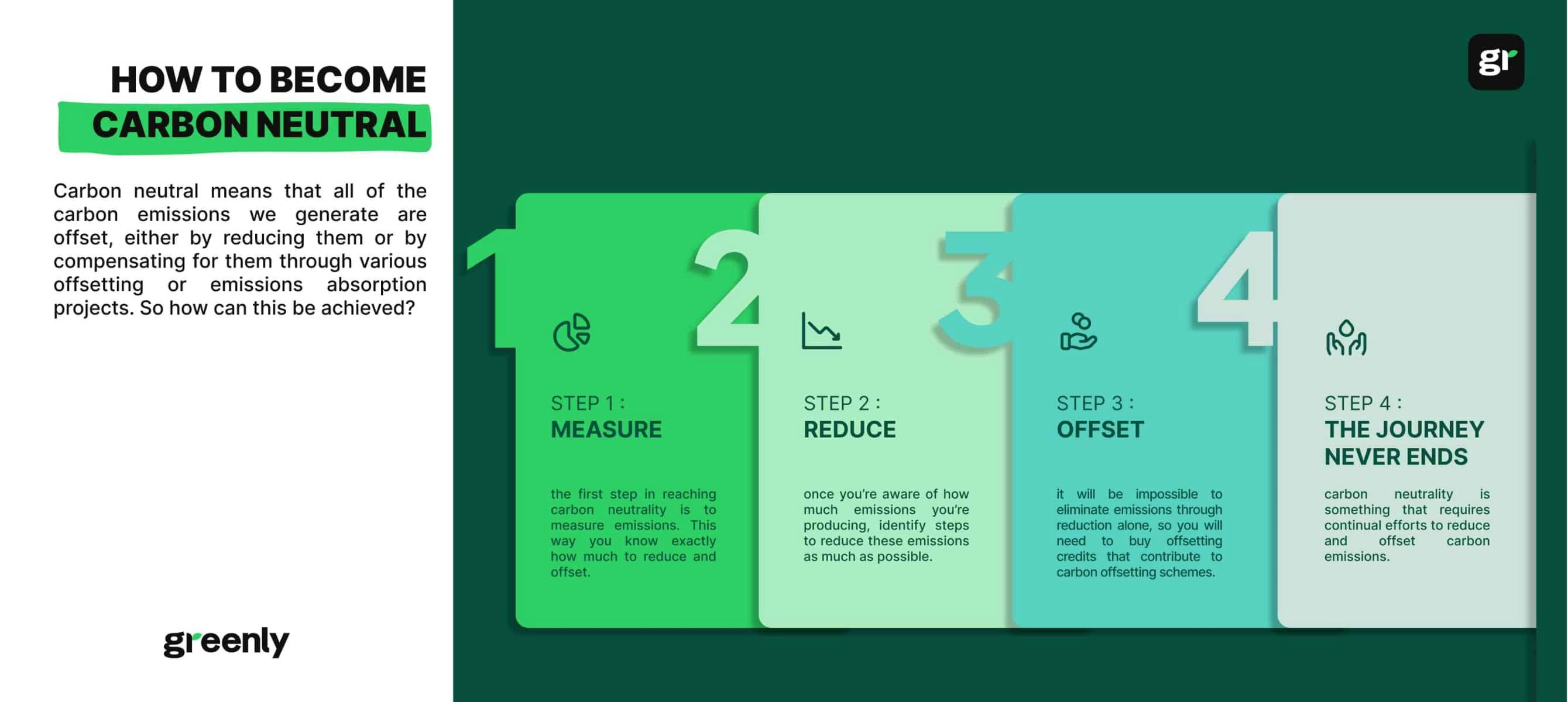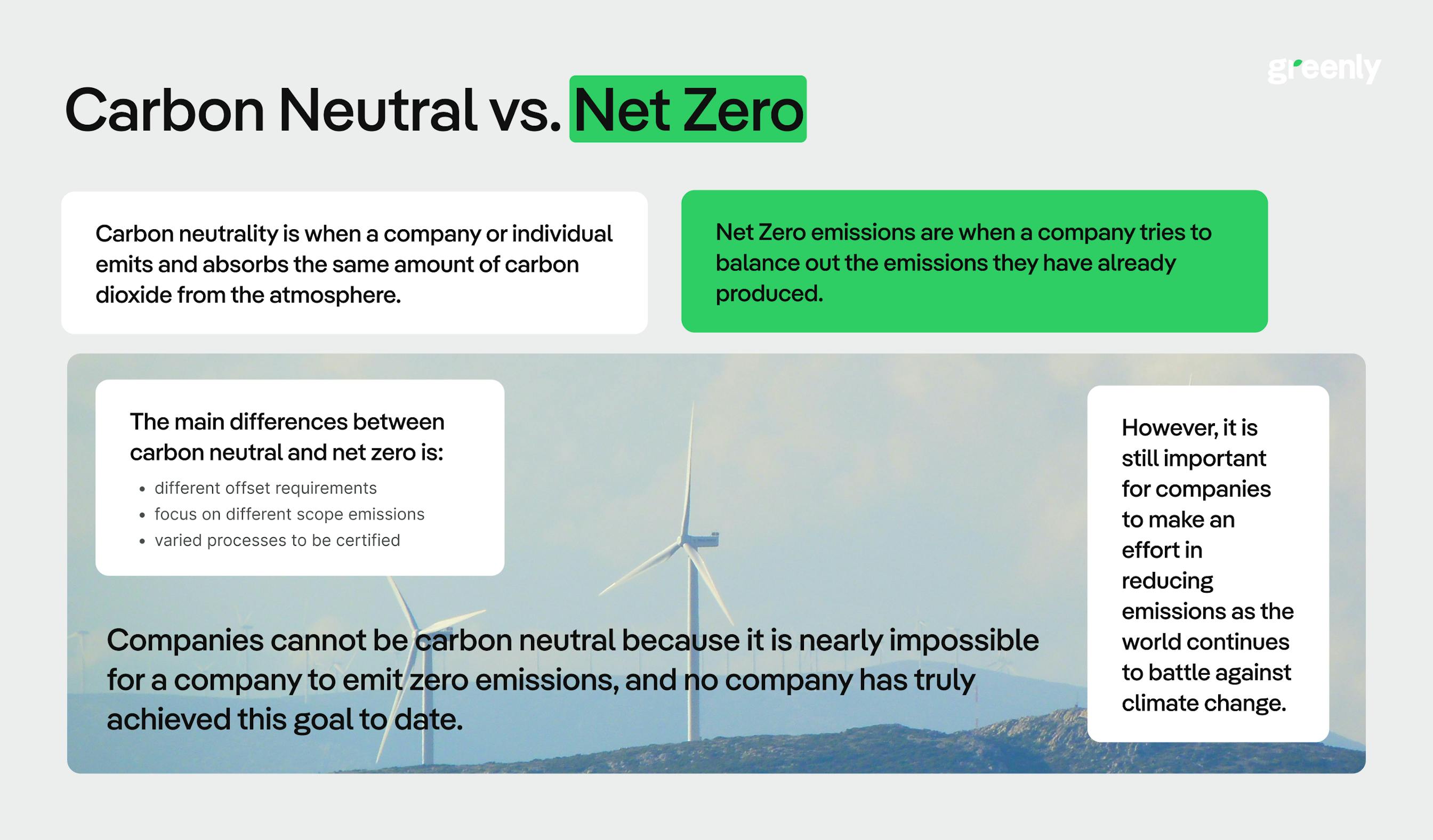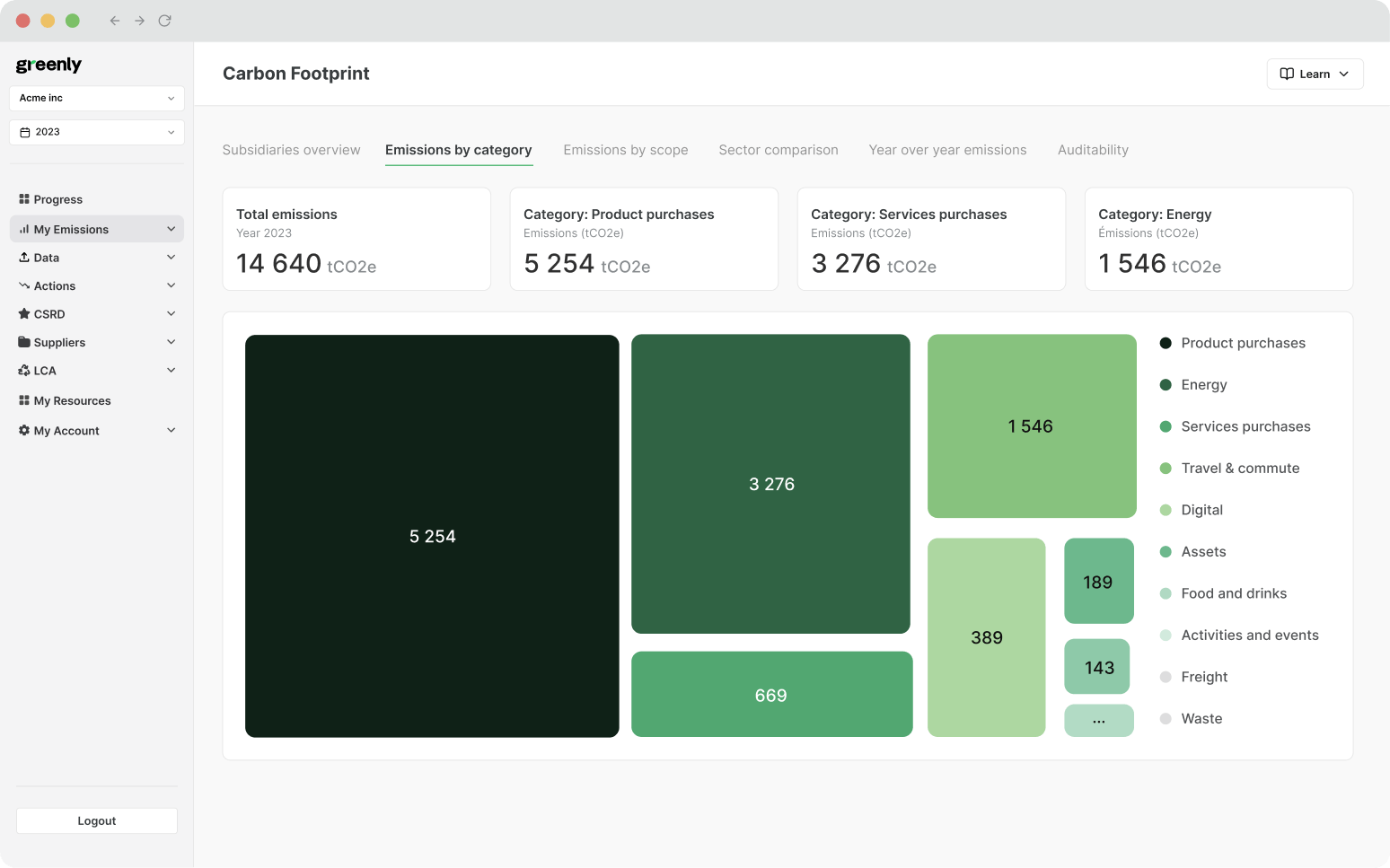
California Climate Accountability Package: SB253, SB261, & SB252
What is the California Climate Accountability Package, and how do SB 253 and SB 261 (SB 219), and SB 252 help the state work towards their environmental goals?
ESG / CSR
Industries



Climate change is a continuously growing problem, and to combat this global predicament – it seems that everyone is trying to commit to achieving net-zero emissions, using renewable energy, or reducing their GHG emissions.
In fact, with so many companies and countries striving to reach net-zero emissions, become carbon neutral, and engage in specific emission reduction projects by a certain point in time – it’s becoming the new norm to be carbon neutral than it is to be otherwise.
While this is an honest and impactful method in attempting to mitigate further climate change, it’s impossible for a company to be completely carbon neutral.
In this article, we'll explain what it means to be carbon neutral, the reality of reducing your own emissions, and if carbon neutrality is really the best way to reduce emissions and fight global warming.
Carbon neutrality is when a company or individual emits and absorbs the same amount of carbon dioxide from the atmosphere.
In other words, the company or individual, “technically” isn’t contributing to carbon footprint, as they ensure to offset all of their own carbon emissions. An example of this is when a company installs a carbon capture and storage system and practices carbon sequestration, which is when carbon is captured and stored beneath the ground to prevent further environmental damage.
Reducing carbon emissions through carbon neutrality is a pathway for the globe to achieve climate neutrality and lower the risk of these natural disasters.
Striving to be carbon neutral is great, but it would take immense worldwide efforts to counterbalance all global greenhouse gas emissions that are provoking climate change, changes in the ecosystem, and natural disasters.
In the midst of mainstream marketing by companies attempting to greenwash their customers and investors, it’s easy to mistake carbon neutral and net-zero carbon emissions to mean the same thing – but they are actually a little different.
Carbon neutrality means that the company is offsetting the equivalent amount of carbon emissions that they are producing – for example, through carbon offsetting projects.
For a company to qualify as a net-zero organization, it means that the project or company practices an activity that doesn’t release more carbon emissions into the atmosphere. In other words, the company is offsetting all of their emissions to the extent that, “technically” – they aren’t producing any new emissions.
However, it's important to remember that neither carbon neutrality or net-zero can be "achieved" by a company, but instead – they can contribute to it as a global goal. In the same way that France can't say they have achieved world peace, no company can say they have achieved carbon neutrality – only that they played a part in working towards a worldwide incentive.
Carbon sinks refer to forests, oceans, or any other environmental resources that are able to absorb carbon dioxide from the atmosphere.
There are a few modifications and various meanings to the term, “net-zero”. Net-zero carbon emissions refers to when a company releases net zero carbon emissions, whereas Net-Zero emissions means that the company strives to counteract all carbon and greenhouse gas emissions released into the atmosphere.


The most common mechanism used by companies and individuals to offset carbon emissions are carbon offsetting projects.
Carbon offsetting projects are when an individual or company invests in an alternative project that strives to reduce environmental damage as a means to counteract their previous carbon footprint and balance out carbon emissions.
Another common way that companies work towards carbon neutrality is through the purchase of carbon credits. Carbon credits are a tradable request that represent an amount of carbon dioxide being removed from the atmosphere in exchange for an individual or company emitting high levels of carbon dioxide or greenhouse gas emissions into the atmosphere.
Carbon offsets and carbon credits are the easiest ways for companies to work towards carbon neutrality.
The truth is, achieving either “net zero” or “carbon neutral” isn’t possible for any company.
This is because the meaning of “net zero” illustrates an overall world-wide goal, where global leaders and company managers alike are striving to reach an equilibrium state of carbon emissions in the atmosphere. Therefore, no single company or organization can claim to have achieved net zero emissions when it is a collective mission to be met.
What companies really mean when they say they are working towards net-zero status, is that they are actively seeking to remove the same amount of carbon dioxide emissions that they are producing from the atmosphere. Therefore, many companies are indeed contributing to the notion of net-zero, but no single company alone is solely responsible for the achievement of net-zero emissions.
The table below will depict the slight differences between carbon neutrality and net zero:
| Aspect | Carbon Neutrality | Net Zero |
|---|---|---|
| Definition | Balancing carbon dioxide (CO₂) emissions by offsetting or removing an equivalent amount. | Reducing all greenhouse gas (GHG) emissions as much as possible, with any remaining emissions offset. |
| Scope | Primarily focuses on CO₂ emissions. | Includes all greenhouse gases (CO₂, methane, nitrous oxide, etc.). |
| Approach | Offsets emissions through carbon credits, reforestation, or carbon capture. | Prioritizes direct emissions reductions before considering offsets. |
| Timeframe | Can be achieved immediately through purchasing offsets. | Requires a long-term strategy for emissions reduction. |
| Ambition Level | Less stringent—allows emissions as long as they are offset. | More ambitious—aims for minimal emissions before offsetting. |
| Regulatory and Business Use | Commonly used by companies to show environmental responsibility. | Encouraged by global climate agreements and stricter regulations. |

While it isn’t possible for a company to constitute themselves as net-zero alone, it’s still more than feasible to develop a sustainable business plan for a company to work towards carbon neutrality by 2050, just as many other companies and countries have committed to this goal.

Many companies are striving for carbon neutrality, as it is slowly becoming an essential requirement for any and all businesses.
A few big name companies that have chosen to take part in the net-zero initiative include Netflix, Facebook, Apple, Coca-Cola, and Amazon.
Companies committed to reducing their use of fossil fuels and offsetting residual emissions can help to remove carbon and contribute to the worldwide objective of carbon neutrality and net zero where there is a balance between the emissions produced and emissions removed.
Here are a few ways companies can contribute to the ideals of carbon neutrality and net zero carbon:

The top ten countries responsible for carbon dioxide emissions are China, the U.S., the European Union, India, Russia, Japan, Brazil, Indonesia, Iran, Canada, and the United Kingdom.
However, some are more committed to achieving net-zero emissions than other countries – separate from their contribution to pollution. For example, the Biden administration has established a plan for the United States to reach net-zero emissions by the year 2050 (which has since been unraveled after Trump's re-election).
Many countries in the EU have laws set in place to make reducing carbon emissions compulsory. For example, Sweden and Germany have put net-zero targets in place for 2045 – and France, Denmark, Spain, Hungary, and Luxembourg plan to achieve net-zero emissions by 2050. Other top carbon emission contributors such as Japan and Canada have made laws to achieve net-zero emissions. The U.K. plans to decrease emissions by 78% by the year 2035.
Even countries that aren’t top contributors are playing their part in the global efforts to achieve net-zero. For instance, Korea and New Zealand have also decided to demand laws to reach net-zero emissions by the year 2050. Also, Ireland, Chile, and Fiji have requested these same net-zero laws to take effect.
There is a big discrepancy between the status of achieving net-zero emissions and being climate positive.
To be net-zero or claim to be carbon neutral means that your company seeks to offset the carbon emissions that they produce. Those emissions are still being produced, but are balanced out through third-party projects or efforts.
On the other hand, to be climate positive means a company or organization not only compensates for their own carbon emissions, but they also establish concrete goals to reduce their own carbon emissions – deeming carbon offsetting projects less necessary.
A net-zero transition strives to balance out carbon emissions, where as being climate positive aims to reduce the need to balance out emitted carbon dioxide in the first place.
Net-zero emissions or claiming carbon neutrality can aid to maintain the current environmental predicament, but it isn’t enough to completely deter or improve the already existing detrimental effects that pollution has had on the planet.
While carbon offsets and carbon credits are good measures to take, companies and individuals should invest in carbon offsetting projects and carbon credits in addition to tackling the source of the problem – the amount of carbon dioxide emissions they produce.
Global and business leaders should establish concrete methods that will decrease carbon emissions and ultimately reduce the need to transition to net-zero emissions in the first place. In other words, companies should strive to be climate positive instead of simply joining the global net-zero movement.
Overall, more companies and individuals around the world would have to commit to more sustainable business methods and lifestyles in order for the globe to really see a difference in how excess carbon emissions are impacting the environment.

Companies aren’t the only ones responsible for creating carbon neutral habits. Everyone around the world should strive to contribute to the global net-zero transition by creating daily routines that protect the environment from further excess carbon emissions.
The first step necessary to create a more environmentally friendly lifestyle is to take note of which parts of your routine produce the most carbon emissions. A carbon footprint calculator can help with this step, and after measuring your carbon footprint – you can begin to delineate the areas for improvement.
Here are a few areas you can take a look at to reduce your carbon footprint in your everyday life.

One of the easiest ways to reduce your carbon footprint is to alter your transportation method. Drive less whenever possible, or opt for greener commutes – like ride shares, walking, biking, or taking the subway or metro.
Our post-pandemic world is going travel-crazy, and while it’s great for the economy – it’s not so great for the environment.
Air travel remains one of the biggest contributors to pollution.
Just like companies, you can choose to offset the carbon emissions you created on your recent airline travel.
Improving energy efficiency at home can decrease both your energy bills and our carbon footprint. Ensuring your home has adequate insulation installed can help reduce the need for central heating or air conditioning. Also, turn off lights or devices when they aren’t being used.
Mitigating the use of a dryer, or purchasing a more energy efficient washing machine can help to reduce water usage – besides taking shorter showers.
Whenever possible, try to not contribute to fast fashion. Try to repair already existing clothing garments, or donate them to a thrift store. Opting to purchase second hand clothing can also reduce your carbon footprint.
Meatless Mondays have helped make it known of the beneficial effects of eating less meat for the environment. Opting for a plant-based diet whenever possible can help reduce carbon emissions and water usage. Also, purchasing and cooking with produce from local markets helps to reduce the need for international shipments to supermarkets.
If reading this article about being carbon neutral in your company has made you interested in reducing your carbon emission to further fight against global warming – Greenly can help you!
Greenly can help you make an environmental change for the better, starting with a carbon footprint assessment to know how much carbon emissions your company produces.
Click here to learn more about Greenly and how we can help you reduce your carbon footprint.
